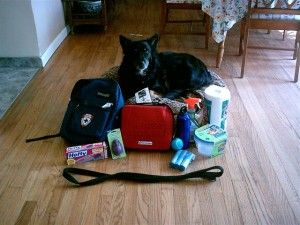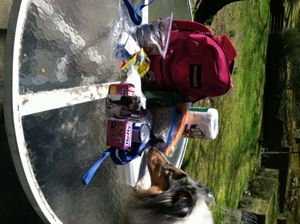By Jo Ellen Cimmino
What is a "Go Kit" and why do I need one?
A Go Kit is a mini survival kit for your pet in case disaster should strike, and you can’t access your regular supplies you may need in the event of an emergency.
Where should I store this Go Kit?
In an accessible location, that is cool, dry and easy to get to for any member of the family (be careful for really small children in case you are storing pet medication). We also suggest using caution if storing it in the kitchen in case of a kitchen fire, but main level near an exit door would be good, or hanging on a peg near the coats in the house. Depending on how many and types of pets you have will determine whether you have separate or multiple Go Kits. It doesn’t matter if you have reptiles, pocket pets, dogs, cats, birds or horses. Any pet you care for should have a backup plan just like you should have one in place for you and your family. If you have children in grades 2-12 they also can participate in putting the kit together. Plus it helps them understand the role of emergency preparedness and they will know where the pack is in the event they should need it.
What do you pack in the Go Kit?
Find either a Tupperware or Rubbermaid storage container, like the type you put holiday decorations in, or a backpack if you are making it for only one family pet. I like to put the pet food in zip lock bags and then place the bag into a plastic bowl (you can use an old cool whip or margarine tub). These can double as a food or water bowl and keeps out the pests that might chew through a plastic bag, depending on where you store this. It would be a shame to go through the labor of putting this together only to find out that mice got in and helped themselves to the Go Kit. 
Measure out food for one week per pet and store it in the zip lock bag or plastic food containers. Measure what your pet eats and then make a daily rations - multiply the amount by seven days. Water: This can be tricky, depending on the daily amount consumed. The average person will need 1 gallon of water each day for consumption and hygiene purposes.
How do you know the amount water to pack for a pet?
Guestimate what your pet consumes and track it for one week. If the pocket pet goes through a water bottle of 12 ounces per day, multiply that times 7 and you have the amount. Always round up not less. For horses, I have used 5 gallon containers with lids, like they sell at contractor stores. They look like the same plastic 5 gallon containers that paint comes in.
You should have minimally two of these stored per horse which is only going to be about a day’s worth of water. If you suspect power will be out, it is recommended that you fill a bath tub full of water for family needs. I would recommend filling up a clean garbage can (with a lid), line it with a large trash bag and fill it ¾ full and tie it off. Store it in the garage or an area where it won’t freeze or be affected by a severe weather event.
Another tip for horse owners - Measure out the amount of food needed for 1 week and store extra bales of hay separate from the Go Kit so they are ready to grab and go, ready in your trailer, if you have access to one. After food and water, figure out what you need to clean up waste. Poop bags for fecal material or garbage bags, kitty litter, an approved disinfectant and paper towels. Be careful about cleaning products if your pet is in contact with them, until rinsed and dried, as many are unsafe.
Don’t forget the First Aid kit.
You can either have one separate for people and pets or combine one for the whole family. Make sure it has pet friendly medication and supplies for your pets. If you have many different kinds of pets, you may need to make a special kit.
How will you transport or contain your pet if you are forced to evacuate from your home?
Does your pet have a travel cage or crate? Do you have bedding or potty pads for travel use? Do you have a leash and collar or harness with identification and contact information that is current? To make temporary identification, take a piece of paper, write your information on it or use a return address label, then put scotch or clear tape over both sides of it so it feels laminated. Attach any new information to collar in case the pet should accidently escape. If you own a horse or livestock that wears a halter you can attach information to the halter.
Keep medical records on hand.
Have a copy of your pet’s medical records, plus a picture of you and your pet for identification purposes. If your pet needs medication, place a week’s worth of them aside in an empty medicine container with their directions and dosage. Have a picture of you and your pet with their medical records, and also keep one on your phone if it has a camera option. Be sure to bring their favorite toy or comfort item, including bedding.
Hint: break in two of the same toy and keep one in the Go Kit. Have a list of pet friendly hotels on hand. Choose a person that you can trust to go and get access to your animals in case you are at work or away on vacation. Make sure you leave a list of instructions and people who know where the Go Kit is. 
Remember to exchange out the food and water every three months, this keeps the food fresh. Mark on your calendar when it is time to recheck the kit for the year and initial it when it has been checked. Have fun making the kit and including family members. Explain its importance and review what is in the kit and why. It doesn’t have to be a chore! Remember, an ounce of prevention may be just the thing that keeps you and your pet from disaster!
Click Here to read Jo Ellen's blog from February, "Be Prepared, Not Scared". Jo Ellen is a 1986 Graduate from SUNY Delhi with a degree in Applied Animal Science, Past President of the NYS Assoc of Veterinary Technicians. She has over 20 years’ experience as a Licensed Veterinary Technician, small animal medicine, and in the past 5 years has also worked part time on call for New England Equine Practice as an anesthesia tech. Jo Ellen teaches Veterinary Radiology for Mercy College in Dobbs Ferry NY for Pre Vet and Veterinary Technology students. She is also a Community Emergency Response Team (CERT) Instructor.
Jo Ellen’s Disaster experience includes: 9/11 treating search and rescue dogs at ground zero, Hurricanes Ivan, Gustov, Katrina and Irene, San Diego Wildfires, Catskill NY and North Dakota Floods, Georgia and Arkansas Tornadoes plus logistical support for the Haiti, and Japan Earthquake efforts. Married 20 yrs with a 16 yr old daughter, Jo Ellen lives in CT on 5 acres with 2 horses, 1 dog, 2 cats, 2 lizards and 1 guinea pig.


